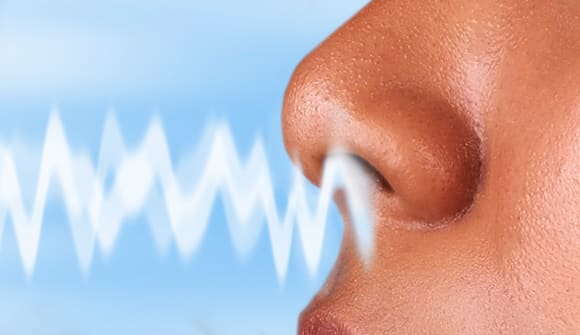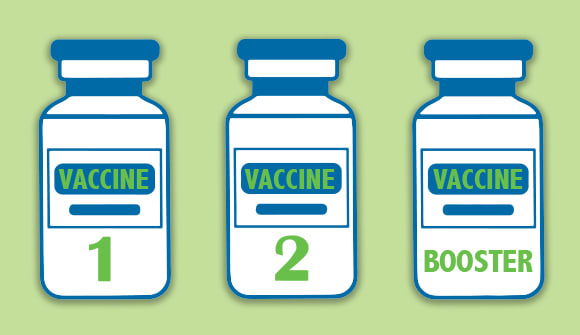Snuffed out sniffer
Why loss of smell may linger months after a COVID-19 infection.
Article Date:

Freshly brewed coffee in the morning. A bouquet of gardenias. The sea breeze. A new car.
Smell is the sense most tied to memory, with the ability to instantly transport you back in time to important parts of life and favorite moments. The sudden absence of this special sense is a hallmark of COVID-19.
Loss of taste and smell have been common symptoms and telltale signs of the coronavirus infection since early in the pandemic. Recent studies published by the National Library of Medicine and the Journal of Internal Medicine suggest up to 80% of people with symptomatic COVID experience smell or taste dysfunction. This ranges from distorted smell and/or taste to complete loss.
In most cases, the senses return after a couple of weeks. But for some survivors, loss of taste or smell can linger for months or longer.
“We still don’t fully understand the mechanisms behind this phenomenon and why it is resolved quickly in some people but not in others,” said Paul Walker, MD, an otolaryngologist (ENT) with North Florida Surgeons. “While research shows these symptoms can persist for months, it also shows smell and taste can return with appropriate treatment.”
Reasons for loss
Viruses, such as the flu and the common cold, have long been known to impact our ability to smell. Congestion or inflammation in the nasal cavity causes swelling that prevents odors from reaching smell receptors that live high up in the nose, resulting in short-term dysfunction or loss.
Other common causes of smell disorders include upper respiratory infections, head injury, tumors, chronic sinus disease and aging. Similar to COVID-19, the changes patients may experience include:
- Anosmia: complete loss of smell
- Hyposmia: partial loss of smell
- Phantosmia: perception of an odor that is not present
- Parosmia: change in the normal perception of a scent
“Smell disorders are actually pretty common in our society,” said Michael Gebel, MD, a neurologist with Baptist Neurology Group and Baptist Medical Center Nassau. “Data shows there are more than 13 million Americans who have a measurable smell disorder like anosmia [complete loss of smell], but those who experience COVID-related anosmia are unique in that their loss is usually dramatic and immediate. The vast majority will also get back their sense of smell in a matter of weeks, unlike most people who experience the condition due to colds and medical disorders such as Alzheimer’s disease.”
“In terms of COVID-19, there is an emerging consensus that loss of smell occurs when the virus infects cells that support sensory neurons in the nose,” said Dr. Walker. “This causes a temporary loss of function and indirectly affects how information relating to smell is transmitted to the brain. Chronic inflammation from an underlying sinus or allergy condition can also delay recovery.”
It’s possible for patients to experience episodes of parosmia or phantosmia as they recover from COVID-19. Scents may become unpleasant or simply different from how a person originally remembered, or someone may smell a phantom odor that doesn’t actually exist.
While medical experts have some understanding of the mechanisms behind olfactory (smell) loss, more research is needed to explain how coronavirus affects taste.
Smell accounts for up to 80% of how flavor is perceived, so people experiencing smell dysfunction may also have loss or reduction of taste. If the nerves relating to smell are not working correctly, then a person will only be able to distinguish the five basic qualities sensed on the tongue: sweet, salty, sour, bitter and savory. Subtle and mild flavors, such as cilantro on rice, will likely be temporarily lost.
Road to recovery
COVID-19 survivors experiencing persistent dysfunction or loss of smell should contact their primary care physician or an ENT as soon as possible. Olfactory neurons responsible for sense of smell can regenerate, but timing is of the essence.
“The biggest thing we’re advocating right now is an essential oil training regimen to try to reawaken the olfactory nerves and restore these neuropathways,” said Dr. Walker. “We use a combination of scented oils that represent four primary smells and corresponding examples, including rose (floral), eucalyptus (herbaceous), lemon (fruity) and clove (aromatic). Patients are asked to inhale each scent for about for 15 to 20 seconds, twice daily, and mentally immerse themselves in what each scent used to smell and look like.”
By combining visual imagery with stimulation of a specific scent, patients can retrain their noses how to smell. If a person is still having issues after three months, Dr. Walker said a physician may switch out the specific scents to a new set of odors that includes menthol, thyme, tangerine and jasmine. After six months, the scents may switch to green tea, bergamot, rosemary and gardenia.
“Our goal is to recreate the correct neural pathways during the healing process,” said Dr. Walker. “So in addition to the olfactory training, we will sometimes use a strong steroid rinse, which has been shown to reduce inflammation. Omega-3 fish oil supplementation may also be recommended as it is a building block for neural tissue.”
If you are experiencing long-term loss of smell or taste due to COVID-19, call 904.202.4YOU (4968) or fill out the appointment request form for help finding an ear, nose and throat specialist near you.



